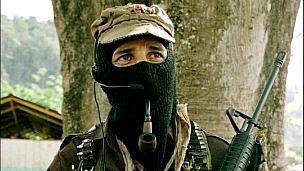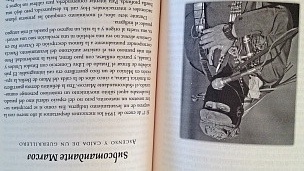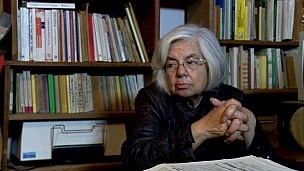Vermp4 From the 60’s and Che Guevara could not see something like a Latin American guerrilla who attracted the eyes of the world and become-with the speed that provided the nascent digital-media in a global icon. That was what happened in 1994 with Marcos, one of the leaders of the Zapatista Army of National Liberation EZLN. Related Content Chiapas: making Mass indigenous Tzotzil Mexico: narco curb violence, is the new Zapatista crusade? Subcomandante Marcos statement published 20 years after the uprising in Chiapas on 1 January of that year, the day he came into force on Free Trade with the United States and Canada, which supposedly symbolized Mexico’s entry into modernity, armed insurrection He reminded the country that the problems anchored to the past. Historian Enrique Krauze, in his book «Redeemers: Ideas and Power in Latin America», describes it: «It was as if he precipitated upon us a meteorite, but not from outer space but the past.» They were only twelve days of combat. The dead were counted by tens not hundreds, but it was enough to attract worldwide attention. Then came the truce, dialogue. And then emerged the figure of Marcos. The balaclava, pipe, his biting humor and finally his prose made him a favorite of the press. He was interviewed by Gabriel García Márquez, greeted by Noam Chomsky and Eduardo Galeano. Praised as the best Latin American writer Regis Debray moment (former student of Louis Althusser, Friend of Che, whom he accompanied in Bolivia and former foreign policy advisor to French President François Mitterrand). Solidarity committees mushroomed across the globe and Chiapas became a magnet for many European-young-looking for a cause they consider just. But not only that: in 1996, in an interview with the commander of the National Liberation Army of Colombia, when asked about the relevance of their armed struggle to bring socialism to power after the fall of the Soviet Union, Nicolas Rodriguez Bautista «Gabino» (current maximum ELN commander) invoked the struggle of the Zapatistas as an example and justification. Media figure: Marcos with features hat, pipe and balaclava. What happened to the frames that emerged 20 years ago as a meteorite in the panorama of Mexican and international left? Improvised?? Several years later, the «sup» Mark would say that much of what happened the first 94 days of January was improvised, including the symbolic masks. That thought never become what he became. In the last interview with a media, published in the Leopard Magazine Mexico in December 2007, explained it as follows journalist Laura Castellanos. «We did not plan well, that was the uprising (…). It became a symbol, but the symbol was originally red bandanna. Now is the balaclava. Started because of the tug of war ‘that the masks are removed and give face ‘And we said.’ well, we’ll take it away and you too, or we are politicians and the whole country ‘and it became a symbol and stayed «.. In his book «Marcos, the great deception» the journalists Bertrand de la Grange and Maite Rico argue that improvisation was much further. Published in 1998, is a story about the Zapatista Subcomandante Fig. There explore the past of Rafael Sebastian Guillen Vicente, whom the government of Ernesto Zedillo revealed, in early 1995, as the real face behind the mask. Mark still refuses. Marcos, is the great Zapatista leader? In his book «Redeemers» historian Enrique Krauze argues that the EZLN, which he considers almost gone-must be analyzed through the prism of the profile and ideas of Subcomandante Marcos, «For as in many other times and periods of history Mexican Neozapatismo was also, to some extent, a social projection of the history of their leaders (chiefs, chiefs, presidents). » It is something that is not in accordance Augusto (not her real name), an «adherent» of the Zapatistas, who has followed the movement for years. He says that at first he could look like, because it was Marcos who spoke and attracted media attention. But, he adds, the movement is essentially indigenous and though Marcos served the important role of interlocutor with national and international civil society, not its leader. And here touches a sore point: «As I see it, it greatly affects a different figure from the Indian height to skin color.». «Because if it had been an indigenous-that there was some Spanish-speaking I do not know what would have happened, if I had equal impact because you have to take into account all indigenous contempt, racism.» «He knew how to reach people in the city and know how to translate what you want the people in the communities.» Finally, remember that, for example, San Andrés agreements were not negotiated or agreed with Mark, but with indigenous leaders, who looked every point with their communities. In the book where they talk with his father, teachers, college excompañeros and guerrilla-is a journey through the life of one who is popularly accepted in Mexico as Mark, born in 1957 ago. He talks about his childhood in the city of Tampico, their radicalization in college, where he studied philosophy, his reading of the French theorists (Althusser, Derrida, Foucault), his fervent admiration for Che Guevara (hint that there comes smoking pipe) and their trips to Nicaragua and Cuba. Finally, tell the Chiapas jungle in merging in 1984 with a handful of fellow, to make revolution. And here is where improvisation comes in: according to De la Grange and Rico, Marcos changed political discourse almost literally overnight: between the 1st and January 6, 1994. Something that has also pointed Enrique Krauze. He spent almost the granite of the first reported to the indigenous and mocking variant that characterized the later Marxist discourse. And how is he? Concepción Villafuerte met Mark when it was Marcos. The story of this woman could also lead to a book. Together with her husband, Amado Avendano founded, wrote and edited-word palaba on a manual press of the eighteenth century, the newspaper El Tiempo (first weekly, then daily) of San Cristobal de las Casas. In January 1994, Concepción and her husband who were alerted international media-and through them the world-, the Zapatista uprising. Were ideally placed to do this: not only lived in San Cristobal, where was the hot core of the armed uprising, but-according to her-it was the only regional means recognizing the existence of the indigenous people of Chiapas. Others simply ignored them. That made the EZLN always give them priority to deliver their communications in the 12-day war January 94. (That same year, Amado Avendaño be a candidate for governor of Chiapas by the Democratic Revolution Party and supported by the EZLN. Always lost and it was alleged that there was fraud). We are at home in San Cristobal, in a room full of photos, old books and memories of her husband, now deceased. There are also boxes and boxes with editions of The Time, also disappeared. One of the photos shows alongside Marcos Amado Avendaño. It’s January 2, one of the first images of the deputy. Journalist Concepción Villafuerte says he sees Mark as a romantic hero Concepción Villafuerte found Marcos in April of that year. As he recounts, after the assassination of Luis Donaldo Colossio official PRI candidate for president (although in Mexico there is no quiet years, 1994 was especially busy), decided to climb the mountains to talk directly with the Zapatistas. After two days of adventures, Marcos met one afternoon at four. «We talked, I wondered very common, almost inconsequential things. I asked him what would happen, because we were nowhere. Had killed Colossio candidate, retired manager of the dialogue by the government with the Zapatistas …». «I said.. ‘We are on red alert because we know nothing, like you’ I found a very kind reported, despite being in the mountains … Very clever A kind of person who starts measuring one , to value «. «He had already made a myth of Marcos and everyone saw it as a very special thing. Conmigo was different, I did not see it as a romantic idol. Talked about serious things, what I was interested to know, as kidnapping of a general, the disappearance of a military. replied Everything. » Many years later Laura Castellanos also met with Marcos in the mountains, but in 2007. Much water had passed under the mill. In 2001, Marcos had what some consider its climax when he traveled to Chiapas to Mexico City in what became known as the March of the Color of the Earth, seeking to enforce the agreements of San Andres, a document signed in 1996 between the EZLN and the government, which promised to make changes in the Constitution to enshrine indigenous rights. Hundreds of foreigners accompanied the deputy and his companions on the journey. More than a million people cheering in the Zocalo of Mexico City. There they were waiting for, among others, José Saramago, Danielle Mitterrand, Manuel Vázquez Montalbán and Alain Touraine. Rivers of ink have run about Marcos and the EZLN. Then came the anticlimax. He explains Professor and researcher Luis Daniel Vázquez, the Latin American Faculty of Social Sciences, FLACSO: «What we have is an interesting interaction between the Zapatistas and the government, which never comes to fruition.» «The last of the very strong learning that has the Zapatista march is the Color of the Earth, where again go with the democratic transition, with Vicente Fox to try to get Congress to pass the agreements of San Andres and translate them into the corresponding constitutional right. » «Congress passes a separate amendment to what was established in these agreements, some more light, especially of indigenous political autonomy. Perhaps most serious is that, with this disappointment, going to the Supreme Court of Justice, Washing hands full. » Zapatista Retraction After that came a period of retreat and silence, both the Zapatistas and Marcos. In 2003 returned to the public stage with its proposal to the Caracoles and Good Governance: associations «Zapatista autonomous municipalities» (29 municipalities are five snails), since then, have given back to the Mexican State (who is called the «bad government») and has been dedicated to building a self-sufficient structure at all levels: economic, health, justice and education. So they have remained until today. In 2006 came another milestone: a presidential election in which the left was able to come to power with Andrés Manuel López Obrador. The Zapatistas decided not to support it. As «AMLO» is known (as it is known in Mexico) lost by a narrow margin against Felipe Calderon, although to this day still says that was fraud, many on the left also noted the Zapatistas. Had they supported, they argue, López Obrador would have won without problems. What about the government? What has been the position of the Mexican government against the EZLN? 20 years, after twelve days of battle, the administration of Carlos Salinas de Gortari ordered a unilateral ceasefire ago. Then came the dialogue process would continue in the government of Enrique Zedillo, however the agreements were never fulfilled. This month, the Mexican magazine «Emeequis» published an article in which, citing secret documents from the Interior Ministry, it is revealed that the strategy Zedillo and his circle was «managing conflict» lengthen, «contain and wearing» a the Zapatistas. Luis Daniel Vazquez, a professor and researcher at FLACSO, believes that the federal government acts, and even for the above «the Zapatistas is not a major problem.» «The Zapatistas, for example, is not part of all that starts off with community policing (or self-defense, many of them of indigenous origin).» Meanwhile, journalist Laura Castellanos says that «what I have observed is that the government’s attitude remains the same as what is considered a low-intensity insurgency.» «You’re not going to throw tanks or army to fight melee or devastate communities. But the state, as it has done on other occasions, uses various tools to put down, split, and one of them is through social programs. » Instead, the EZLN and their supporters launched «The Other Campaign». So the professor explains Flacso the BBC: «His logic is ‘we do not have to think to the left from above but from below’ and from that ‘bottom left’-new motto-their goal is to give. to know very local movements that may have the same political problems but they are not interconnected.’s the same bet of the Snails «. The last public exit Marcos is then presented: adopts the name «Delegate Zero» for a year and covers the 31 states of Mexico, plus the Federal District, meeting with representatives of those movements. Then go back to Chiapas and does not come out of the mountains. At least visibly. «Media Invisibility» A journalist Laura Castellanos, Mark seemed «a very witty and intelligent man.» «Mainly what struck me was the process of self-criticism. ‘Cause one thing to be self-critical when you’re on top, but when you are in a time of media invisibility, questioning, criticism, is not easy,» says the BBC. The interview, published as a book in 2008 under the name «Court Case», is illuminating. It takes stock of frames throughout this period. How he and his movement had «old fashioned», how, according to his version, the traditional Mexican left remain supported while in Chiapas: «I had a kind of division of labor: ‘you speak there and write poems (… ) and we take care of the politics of the great ‘. » He also spoke of some groups of European solidarity, «Do not dare to say so openly, but expressed ‘no, it is that the Zapatistas already out of fashion, it is not like before, if you do not already have the media attention to what support (…) «. Among the most interesting interview that his gaze on his own phenomenon is. Marcos icon. «The attraction is the symbol, not one … for the mystery, the mask, which also attract all that was cultivated by the media.» You also agree that your figure, magnified by the press, became the symbol of the EZLN, especially at the beginning of the uprising, «Yes overestimation of what could be achieved using the media was given, it was in the 94 when the movement itself came to light in the media worldwide and practically passed that year from interview to interview. » He adds that if I could change anything, it would be part of that media. «Make an effort to be less concentrated attention on the figure of Marcos, precisely in the early years. Later because we wanted to eliminate it and could not.» School in the Zapatista Caracol of Oventic in Chiapas. After that interview, Marcos tried to remedy it. He fell into the media silence. Then the rumors began: that she was seriously ill. Who had died, who lived in Mexico City, more precisely in the affluent Colonia Roma. But occasionally shows signs of life through stories in Revolt Magazine or some press. One of the last, last December 22, is titled «Rewind 2: Death and other alibis» (December 28, he released «Rewind 1»). There, besides the many postscripts, again on issues that are expensive, such as death. And back to the issue of identity, the face behind the mask. «It took another name and hide his face, is to hide from the enemy or to challenge your ladder etc., hierarchical naming, its offer of sale and be disguised as bureaucratic positions, awards, praise and praise, big clubs or small fan? «. As seen in the long pueder statement from the shadows, pen Subcomandante Marcos remains so popular and followed but, yes just as poignant and lyrical.
http://wsodprogrf.bbc.co.uk/mundo/dps/2013/12/181213_video_zapatistas_aniversario_mr_16x9_lo.mp4



